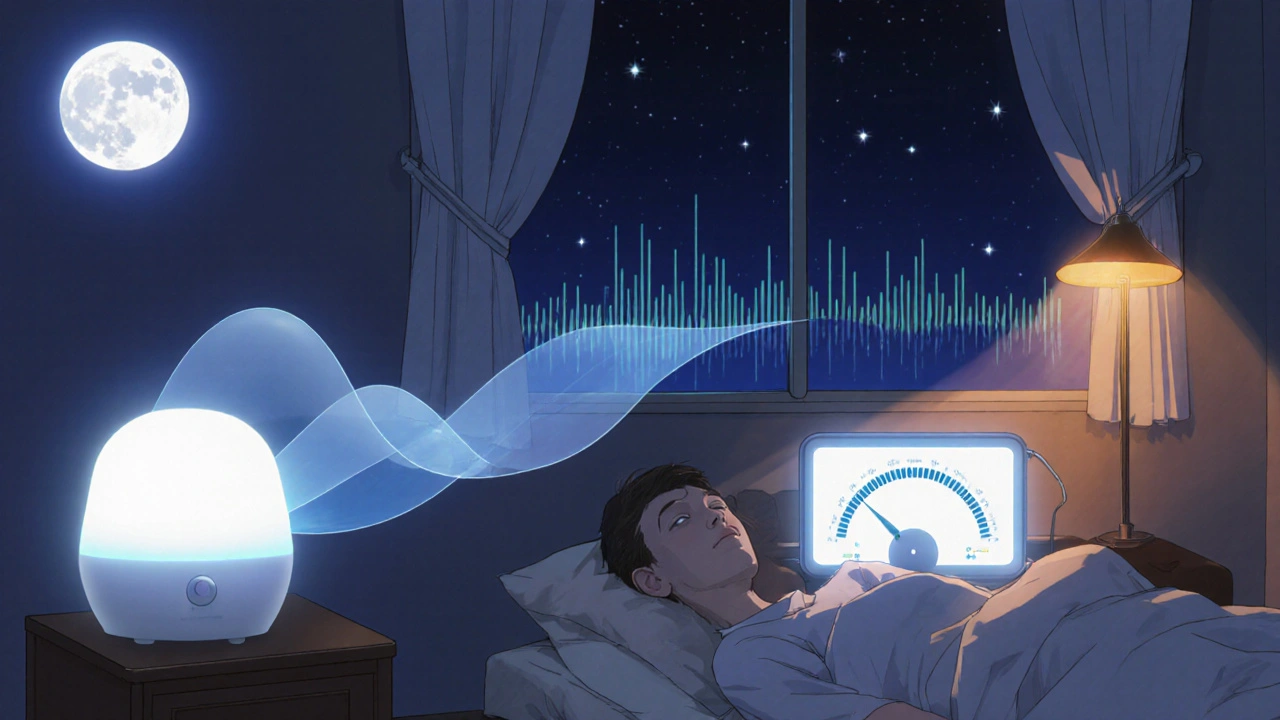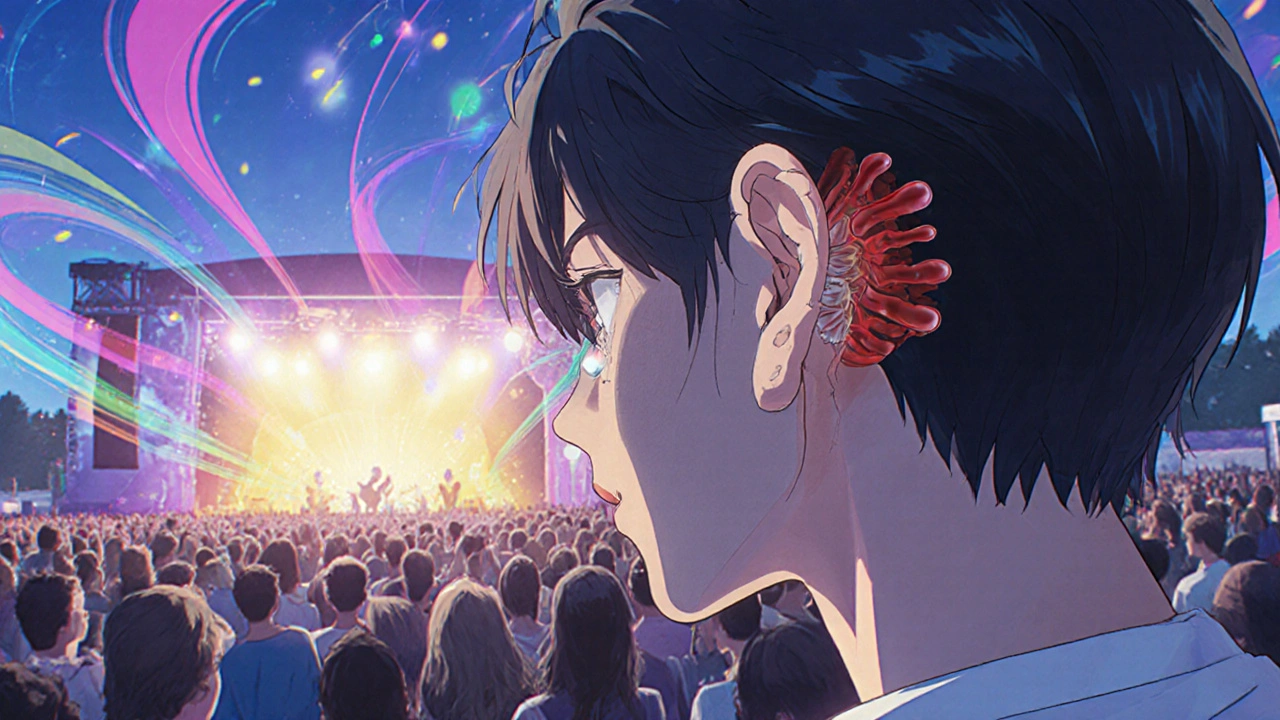Hearing Protection Calculator
Assess your noise exposure risk and get personalized ear protection recommendations based on dB levels and duration.
How This Works
This calculator uses OSHA safety guidelines. For noise above 85 dB, exposure time must be reduced to prevent hearing damage. The recommended ear protection must reduce noise to safe levels.
Ever notice a faint buzz after a concert or a sudden high‑pitched whine after mowing the lawn? That annoying sound is more than a nuisance - it can be an early warning sign that your hearing is under stress. Below is a straight‑forward plan to protect your ears and prevent ringing in the ears before it becomes a chronic problem.
What is the ringing we hear?
Tinnitus is the perception of sound, such as ringing, buzzing, hissing, or clicking, without an external source. It affects about 15% of adults worldwide and can range from a brief annoyance to a constant, debilitating noise. While tinnitus itself isn’t a disease, it often signals that something inside the ear or auditory pathway is out of balance.
Why does noise damage our ears?
Sound travels as pressure waves that vibrate tiny hair cells inside the cochlea. These hair cells turn mechanical motion into electrical signals that the brain interprets as sound. When exposed to loud volumes (above 85 dB SPL) for extended periods, the hair cells begin to fatigue, shrink, or even die. Unlike skin cells, once these hair cells are lost, they don’t grow back, leading to permanent hearing loss and increased risk of tinnitus.
Common culprits that raise your tinnitus risk
- Live music venues or festivals without proper ear protection
- Power tools, lawn mowers, leaf blowers - often exceed 100 dB
- Personal audio devices at >80 % volume for more than an hour a day
- High‑decibel entertainment systems in cars or home theaters
- Repeated exposure to sudden loud noises, like fireworks
Even if you don’t feel immediate pain, these noises can accumulate damage over weeks, months, or years.

Effective ear‑protection options
Earplugs are small insertable devices that reduce sound pressure by sealing the ear canal. They’re cheap, portable, and work for most daily situations.
Noise‑Induced Hearing Loss refers to permanent hearing damage caused by prolonged exposure to high decibel levels. Using earplugs and earmuffs can dramatically lower the risk of this condition.
Here’s a quick comparison of the most common protective gear:
| Type | Typical NRR (dB) | Comfort | Best For |
|---|---|---|---|
| Foam earplugs | 22‑33 | High (soft, disposable) | Concerts, DIY projects |
| Silicone flanged plugs | 20‑25 | Medium (re‑usable) | Travel, sleep |
| Custom‑molded plugs | 25‑30 | Very high (personal fit) | Professional musicians, frequent users |
| Earmuffs | 15‑30 | Variable (depends on padding) | Power tools, shooting ranges |
If you work with noisy equipment daily, consider a combination of high‑NRR earmuffs over reusable silicone plugs for double protection.
Lifestyle factors that can trigger or worsen tinnitus
Noise isn’t the only player. Several everyday habits subtly increase the odds of ringing ears:
- Ototoxic Medications (e.g., certain antibiotics, diuretics, chemotherapy drugs) can damage inner‑ear hair cells.
- High caffeine or alcohol intake can heighten blood flow changes in the inner ear, making the ringing more noticeable.
- Stress and anxiety amplify the brain’s perception of tinnitus. A calm mind often hears less phantom noise.
- Excessive earwax buildup can block the ear canal, creating pressure changes that mimic ringing.
- Poor sleep hygiene reduces the brain’s ability to filter out unwanted sounds.
Addressing these factors can make a noticeable difference, even if you’ve already experienced occasional ringing.
Screening and early detection
Regular hearing checks are the smartest way to catch problems before they lock in. An Audiometer is a clinical device that plays tones at varying frequencies and volumes to map your hearing thresholds. Many pharmacies and community health centers in Australia offer free or low‑cost hearing screenings.
If a test shows a dip in the high‑frequency range (3‑8 kHz), you’re likely already experiencing early noise‑induced damage. Take action promptly: reduce volume, wear ear protection, and schedule a follow‑up with an audiologist.

Step‑by‑step action plan
- Assess your exposure. Keep a one‑week log of noisy activities and device volumes.
- Choose the right protection. Match the gear from the comparison table to your most common loud environments.
- Implement daily habits. Lower headphone volume, take 5‑minute quiet breaks every hour, stay hydrated.
- Manage stress. Try simple mindfulness, breathing exercises, or a short walk after noisy work.
- Watch meds and diet. Talk to your doctor about ototoxic drugs, limit caffeine/alcohol in the evening.
- Schedule a hearing test. Aim for a baseline by age 30, then every 2‑3 years.
- Monitor symptoms. If ringing lasts more than a few days after exposure, consult an ENT specialist.
Following this checklist reduces your risk of permanent tinnitus and keeps your hearing sharp for the long haul.
Bonus: Using sound therapy for existing tinnitus
When ringing does appear, masking it with soothing background sounds can provide relief. A White Noise Machine produces consistent, broadband sound that helps the brain ignore phantom noises. Choose a device with adjustable volume and a timer for bedtime use.
Couple sound therapy with relaxation techniques and you’ll often notice the ringing fades into the background rather than dominating your thoughts.
Frequently Asked Questions
Can I reverse tinnitus once it starts?
Complete reversal is rare, but many people reduce the intensity by eliminating triggers, using sound therapy, and managing stress. Early intervention gives the best chance of relief.
Do over‑the‑counter earplugs really work?
Yes, especially foam plugs with a high Noise Reduction Rating (NRR). For optimal protection, roll the plug, insert fully, and let it expand for a tight seal.
Are there any foods that help prevent tinnitus?
Antioxidant‑rich foods-berries, leafy greens, nuts-support vascular health in the inner ear. Keeping magnesium levels up (banana, dark chocolate) may also protect hair cells.
How often should I replace my earplugs?
Disposable foam plugs should be swapped after each use. Reusable silicone or custom plugs can last months but need regular cleaning and visual inspection for wear.
Is tinnitus linked to hearing loss?
Often. Damage to high‑frequency hair cells can create the phantom sounds we call tinnitus. That’s why hearing tests are essential when ringing appears.
Protecting your ears isn’t a one‑time task; it’s a series of small, repeatable choices. By understanding the causes, using the right gear, and staying mindful of lifestyle factors, you give yourself the best shot at a quiet, healthy future.



5 Comments
Sarah Unrath
October 19, 2025 AT 18:53i was at a backyard bbq last weekend the music was pumpin my ears were ringing afterward i didnt think much but then i read this guide and realised i should have worn some cheap foam plugs next time its kinda crazy how fast those loud speakers can fry your hair cells
James Dean
November 3, 2025 AT 19:00The acoustic trauma described here underscores a fundamental principle of auditory physiology: prolonged exposure to amplitudes above the 85 dB threshold initiates irreversible metabolic fatigue within the organ of Corti
Monika Bozkurt
November 18, 2025 AT 20:07From a clinical perspective, the etiopathogenesis of tinnitus can be parsed into two primary mechanistic axes: peripheral cochlear degeneration and central auditory plasticity. Peripheral damage, often precipitated by acute or chronic exposure to supra-threshold sound pressure levels, leads to the loss of outer hair cell stereocilia, thereby compromising the electromotile amplification process. Consequently, the diminished afferent input incites homeostatic upregulation of central gain within the dorsal cochlear nucleus and inferior colliculus, manifesting as phantom auditory perception. Moreover, neurovascular coupling disruptions, frequently mediated by ototoxic pharmacological agents, exacerbate the metabolic vulnerability of inner ear stria vascularis cells, further amplifying oxidative stress. Lifestyle modifiers, including excessive caffeine consumption and alcohol-induced vasodilation, modulate cochlear blood flow dynamics, potentially precipitating transient spikes in perceived ringing. Stress and anxiety, through limbic system activation, can potentiate the salience of tinnitus via top-down attentional bias, highlighting the psychosomatic interplay. Preventative measures thus demand a multimodal strategy: ergonomic sound attenuation via high-NRR earplugs, judicious volume regulation on personal audio devices, and periodic audiometric surveillance to detect subclinical threshold shifts. In occupational settings where noise exposure routinely exceeds 100 dB SPL, the implementation of double-layered protection-custom-molded inserts coupled with over-the-ear earmuffs-has been empirically validated to reduce cumulative dose by up to 75%. When tinnitus does emerge, sound therapy employing broadband white noise or narrowband notched music can facilitate cortical reorganization by promoting stochastic resonance, thereby attenuating the perceived intensity of the phantom signal. Finally, nutraceutical interventions rich in antioxidants-such as flavonoid-dense berries and magnesium-containing legumes-may confer cytoprotective effects on hair cells by scavenging free radicals and stabilizing mitochondrial function. In sum, a comprehensive, evidence-based prophylactic regimen, anchored in both acoustic and lifestyle domains, remains the cornerstone of tinnitus mitigation.
Caroline Keller
December 3, 2025 AT 21:13aw i get it the science is solid but let me tell you how it feels when you ignore the warnings-last summer at a music festival I was dancing nonstop and by the end of the night my head felt like it was inside a tin can the buzzing wouldn’t quit i felt miserable the next day and it really scared me i kept thinking about the article and finally I bought a pair of silicone flanged plugs and they actually made a huge difference the next concert i was able to enjoy the music without that lingering echo in my ears it was like a weight was lifted i want everyone to know that you don’t have to sacrifice fun for safety you just need the right gear i’m not trying to sound dramatic i just want people to protect themselves before it’s too late
dennis turcios
December 18, 2025 AT 22:20The guide is decent but it glosses over the cost-benefit analysis of custom‑molded plugs versus disposable foam. For casual users, the incremental protection may not justify the expense, yet the article doesn’t flag this nuance. Also, the table omits low‑profile earbuds that claim built‑in attenuation, which could mislead readers seeking all‑in‑one solutions. Overall, a solid overview but lacking critical depth on economic trade‑offs.